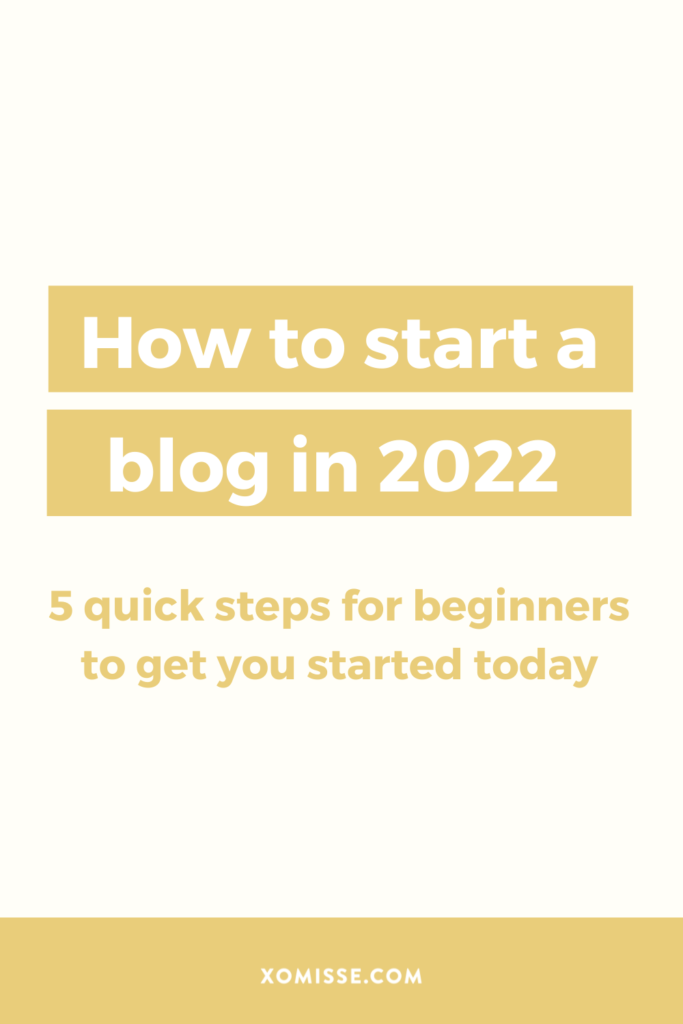Have you wanted to start a blog for a while now, but you’re stuck on where to start? In this post, I’ll guide you through the 5 simple steps to starting a blog that will have you online within one hour.

This page contains affiliate links. If you click on these links and choose to purchase something, I may receive a commission at no extra cost to you. I only recommend products and services that I trust to be useful and of high quality, whether an affiliate relationship is in place or not.
Wait, isn’t blogging dead?
You may have seen the phrase “blogging is dead” flying around the Internet lately… but if you saw my previous post about the benefits of blogging, you’ll know that I don’t believe that it is.
Okay sure, social media has probably replaced the generic lifestyle or diary-style blog. But having a website with content on a specific topic… in my opinion, is not dead. It actually plays a vital role in content marketing and search engine optimisation.
Should you start a blog? In my opinion, yes you should!
Ready to start a blog? Here are 5 steps to get you online today…
Our goal in this post is to get you to start a blog so that it’s up and running right away. I don’t want to overwhelm you with too many options, so I’m going to focus on just the main steps below. Once you’ve completed this and started your blog, you can concentrate on growing traffic and monetising it.
1. Choose your blog topic
First up is figuring out is what content you’re going to be discussing. Identify content pillars – what 3-5 themes or topics are you focusing on? These should align with the pain points of your ideal audience and your interests or expertise.
Do I need a niche?
When you get started in blogging, you’ll notice the topic of having a niche comes up over and over again.
Niche blogging is when you write about a narrow topic that appeals to a specific group of readers. You are targeting a particular genre, topic or location and essentially specialising in a topic to really hone in on a group of readers.
There is always a debate on whether or not you can be successful if you don’t have a niche blog. There are pros and cons to both, but in my experience the advantages of having a niche blog outweigh the disadvantages.
2. Figure out your target audience
The other thing you need to know is your target audience? This will identify who you are speaking to when it comes to creating content, offering services, developing products and everything else you go on to do.
Knowing exactly who your product and/or service is for, or who you are writing for, will really help you. You’ll be able to understand their mindset, figure out exactly what they need and cater everything you do directly to them.
3. Choose your platform
The next step selecting the platform you’re going to use. There’s two types of platforms – hosted and self-hosted – with multiple options for each. I recommend Blogger and WordPress.
Related: Overview of WordPress, Blogger and other platforms
Let’s have a quick look over the options:
Hosted platforms – Blogger and WordPress.com
If you’re looking to get started completely for free, I’d recommend choosing a hosted platform. These include Blogger.com, WordPress.com, Squarespace, Wix and Medium.
These platforms are free because they are hosted – that means the platform’s team look after the backend stuff like security and updates.
They can be slightly limited in terms of features and functionality, but the benefit is that you don’t need any extras. Though, I do recommend purchasing a domain to use instead of the default .blogspot.com or .wordpress.com address as it will look more professional and you can start building your domain authority.
Related: What is the difference between hosted and self-hosted blogging platforms
Self-hosted platform – WordPress.org
If you’re willing to invest a little bit of time and money, I’d highly recommend going self-hosted with WordPress.org.
WordPress.org is the leading CMS (content management system), which allows you to build a website and/or blog and gives you full control over your blog, the design, functionality and everything else.
For this you’ll need a web host, which will “store” your site, and a domain. Then you need to install the WordPress software on your hosting and domain.
Check out my post on how to install and setup self-hosted WordPress to get your new WordPress site up-and-running in 4 steps.
4. Set up your new blog
Now that you’ve chosen your platform, there are a couple of things you may want to set up before you get started.
If you’ve chosen WordPress, I’d recommend reading my beginner’s guide to using WordPress and going through the 35 things to do after installing WordPress for full steps on setting up your new WordPress site.
No matter what platform you choose I’d recommend writing an about page with contact information, then setting up a navigation menu containing a links to your blog post archive and about page. You can expand on these pages later but essentially you want to let people know who you are, what content you’ll be creating and how to get in touch with you.
5. Write your first post
Now is time to get writing. You’ll create your content under the Posts section. Here you can give your post a title, build the content, apply categories or tags for navigation purposes, add a featured thumbnail image and publish your post.
This will automatically show on your blog post archive in reverse chronological order, with the most recent post showing first.
Congratulations!
You are officially a blogger! You now have a brand new blog with your first published post.
Looking to increase your traffic? Take a look at these 5 ways to find new readers and build an engaged audience.